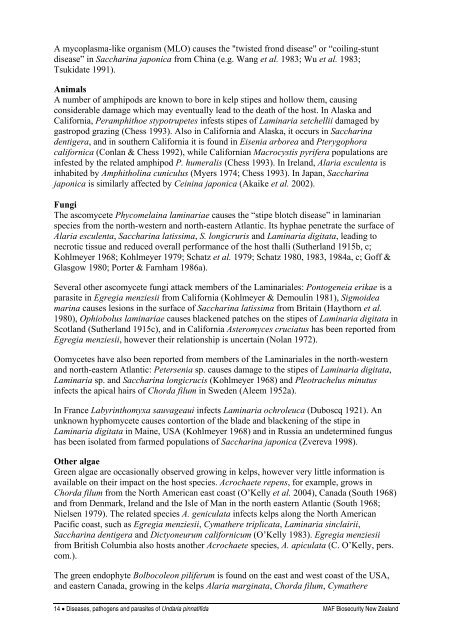Diseases, pathogens and parasites of Undaria pinnatifida
Diseases, pathogens and parasites of Undaria pinnatifida
Diseases, pathogens and parasites of Undaria pinnatifida
Create successful ePaper yourself
Turn your PDF publications into a flip-book with our unique Google optimized e-Paper software.
A mycoplasma-like organism (MLO) causes the "twisted frond disease" or “coiling-stunt<br />
disease” in Saccharina japonica from China (e.g. Wang et al. 1983; Wu et al. 1983;<br />
Tsukidate 1991).<br />
Animals<br />
A number <strong>of</strong> amphipods are known to bore in kelp stipes <strong>and</strong> hollow them, causing<br />
considerable damage which may eventually lead to the death <strong>of</strong> the host. In Alaska <strong>and</strong><br />
California, Peramphithoe stypotrupetes infests stipes <strong>of</strong> Laminaria setchellii damaged by<br />
gastropod grazing (Chess 1993). Also in California <strong>and</strong> Alaska, it occurs in Saccharina<br />
dentigera, <strong>and</strong> in southern California it is found in Eisenia arborea <strong>and</strong> Pterygophora<br />
californica (Conlan & Chess 1992), while Californian Macrocystis pyrifera populations are<br />
infested by the related amphipod P. humeralis (Chess 1993). In Irel<strong>and</strong>, Alaria esculenta is<br />
inhabited by Amphitholina cuniculus (Myers 1974; Chess 1993). In Japan, Saccharina<br />
japonica is similarly affected by Ceinina japonica (Akaike et al. 2002).<br />
Fungi<br />
The ascomycete Phycomelaina laminariae causes the “stipe blotch disease” in laminarian<br />
species from the north-western <strong>and</strong> north-eastern Atlantic. Its hyphae penetrate the surface <strong>of</strong><br />
Alaria esculenta, Saccharina latissima, S. longicruris <strong>and</strong> Laminaria digitata, leading to<br />
necrotic tissue <strong>and</strong> reduced overall performance <strong>of</strong> the host thalli (Sutherl<strong>and</strong> 1915b, c;<br />
Kohlmeyer 1968; Kohlmeyer 1979; Schatz et al. 1979; Schatz 1980, 1983, 1984a, c; G<strong>of</strong>f &<br />
Glasgow 1980; Porter & Farnham 1986a).<br />
Several other ascomycete fungi attack members <strong>of</strong> the Laminariales: Pontogeneia erikae is a<br />
parasite in Egregia menziesii from California (Kohlmeyer & Demoulin 1981), Sigmoidea<br />
marina causes lesions in the surface <strong>of</strong> Saccharina latissima from Britain (Haythorn et al.<br />
1980), Ophiobolus laminariae causes blackened patches on the stipes <strong>of</strong> Laminaria digitata in<br />
Scotl<strong>and</strong> (Sutherl<strong>and</strong> 1915c), <strong>and</strong> in California Asteromyces cruciatus has been reported from<br />
Egregia menziesii, however their relationship is uncertain (Nolan 1972).<br />
Oomycetes have also been reported from members <strong>of</strong> the Laminariales in the north-western<br />
<strong>and</strong> north-eastern Atlantic: Petersenia sp. causes damage to the stipes <strong>of</strong> Laminaria digitata,<br />
Laminaria sp. <strong>and</strong> Saccharina longicrucis (Kohlmeyer 1968) <strong>and</strong> Pleotrachelus minutus<br />
infects the apical hairs <strong>of</strong> Chorda filum in Sweden (Aleem 1952a).<br />
In France Labyrinthomyxa sauvageaui infects Laminaria ochroleuca (Duboscq 1921). An<br />
unknown hyphomycete causes contortion <strong>of</strong> the blade <strong>and</strong> blackening <strong>of</strong> the stipe in<br />
Laminaria digitata in Maine, USA (Kohlmeyer 1968) <strong>and</strong> in Russia an undetermined fungus<br />
has been isolated from farmed populations <strong>of</strong> Saccharina japonica (Zvereva 1998).<br />
Other algae<br />
Green algae are occasionally observed growing in kelps, however very little information is<br />
available on their impact on the host species. Acrochaete repens, for example, grows in<br />
Chorda filum from the North American east coast (O’Kelly et al. 2004), Canada (South 1968)<br />
<strong>and</strong> from Denmark, Irel<strong>and</strong> <strong>and</strong> the Isle <strong>of</strong> Man in the north eastern Atlantic (South 1968;<br />
Nielsen 1979). The related species A. geniculata infects kelps along the North American<br />
Pacific coast, such as Egregia menziesii, Cymathere triplicata, Laminaria sinclairii,<br />
Saccharina dentigera <strong>and</strong> Dictyoneurum californicum (O’Kelly 1983). Egregia menziesii<br />
from British Columbia also hosts another Acrochaete species, A. apiculata (C. O’Kelly, pers.<br />
com.).<br />
The green endophyte Bolbocoleon piliferum is found on the east <strong>and</strong> west coast <strong>of</strong> the USA,<br />
<strong>and</strong> eastern Canada, growing in the kelps Alaria marginata, Chorda filum, Cymathere<br />
14 • <strong>Diseases</strong>, <strong>pathogens</strong> <strong>and</strong> <strong>parasites</strong> <strong>of</strong> <strong>Undaria</strong> <strong>pinnatifida</strong> MAF Biosecurity New Zeal<strong>and</strong>

















